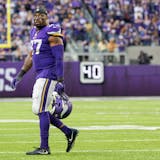Max Kepler wasn't about to give away any secrets. The Twins outfielder was talking recently about his improvement at the plate and said: "I'm aware of what my pitch is."
The natural follow-up: "Well, what is your pitch?"
Kepler gave a sly smile.
"I'd rather not give that away," he said. "Pitchers might be listening."
They need to be paying more attention to Kepler, who seems to be maturing in his third full season in the big leagues. If you look at Kepler's batting average, you'll notice not much has changed from a year ago — .241 in 2018 compared to .243 to 2017. But if you look a little deeper, you'd see the 25-year-old is steadily improving in a number of key areas, even if Kepler has been hitless in his past five games.
To put it simply: Kepler is hitting the ball harder more often. Perhaps the most striking statistic is the number of "barrels" he has accumulated. According to Statcast, a hitter gets a "barrel" when the launch angle and the exit velocity of a batted ball combine in a mathematical combination that typically results in an extra-base hit. Usually, the exit velocity has to be around or above 100 miles per hour and the launch angle has to be in the mid 20s to low 30s, the ideal launch angle for home runs.
Kepler only had 12 such moments of contact in 2016, 16 in 2017 but already has 10 in 2018. Kepler and hitting coach James Rowson have attributed this to Kepler getting more experience at the plate — to know when to swing at "his pitch."
"He's staying in a really strong position to hit longer, and he's calmed down at the plate," Rowson said. "The more you relax and see the ball a bit easier and you don't have that anxiety behind you, the better off you're going to be able to identify pitches."



